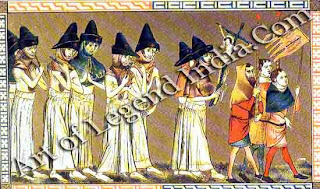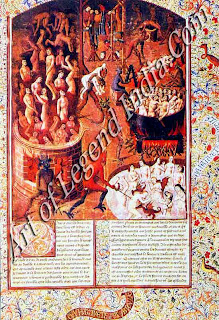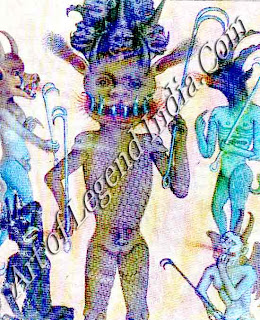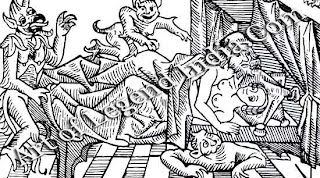 The Eve of Destruction
The Eve of Destruction
Dominated
by obsessions with witches, devils, death and decay, the late Middle Ages was a
period of anxiety and uncertainty when people believed themselves to be on the
brink of destruction.
Life in
Europe towards the end of the middle Ages was dominated by a conflict between
the promptings of the flesh and those of the spirit. It was an age of strong
contrasts, a time of passion and violence. Everyday existence was almost casual
in its brutality: lepers walked the streets and public executions were
frequent, often theatrical, and very well attended. The popular imagination was
obsessed with the idea of death the reality of dying rather than the
possibility of heavenly salvation to follow.
It was
generally believed that even Lazarus, after his resurrection, lived in terror
at the thought of having to pass again through the gates of death. And Lazarus
had been one of the just what could an ordinary sinner expect?
Daily
existence was intended to be a preparation for the afterlife, but the reality
was inevitably worldlier. The Church fathers preached that all earthly beauty
and pleasure was sinful, but a common reaction in those uncertain times was
'enjoy yourself as much as you can, while you can'. It was this emphasis on the
demands of the body at the expense of the soul which Bosch attacked. He painted
from the standpoint of orthodox Catholicism he was himself a member of the
Brotherhood of Our Lady with an uncompromising certainty which seems to owe
something to propaganda.
UNGODLY EXAMPLE
 People
clearly wanted to be reassured by the authority of the Church, but the clergy
were failing in their duty, as they repeatedly prey to the sins of lust and
greed. Despite the Church ruling of lived openly with women and fathered
children. Their blatant conduct caused great offence. And trust was further
undermined by bands of bogus monks and friars who travelled around selling
false relics and pardons.
People
clearly wanted to be reassured by the authority of the Church, but the clergy
were failing in their duty, as they repeatedly prey to the sins of lust and
greed. Despite the Church ruling of lived openly with women and fathered
children. Their blatant conduct caused great offence. And trust was further
undermined by bands of bogus monks and friars who travelled around selling
false relics and pardons.
Meanwhile,
the more senior officers of the Church led sumptuous and extravagant lives.
Pope Alexander VI, himself a member of the notoriously corrupt Borgia family,
rather hypocritically attempted to enforce a reform bill in 1497 curtailing the
activities of the pleasure-loving Cardinals and restricting their vast
households to a mere 80 strong.
Where
preachers could not convince by godly example and this was the rule rather than
the exception they discouraged sin by stressing the torments of Hell. Sin
provided more opportunities for lavish and inventive imagery than the calm
spiritual grace of a holy life. This morbid fascination accounted for the
success of a book appearing around 1486, the Witches' Hammer, which classified
the many types of witch and described their relations with devils. The demons
in Bosch's paintings were not simply the product of imagination they had a
vivid reality for a superstitious age.
DIVINE VENGEANCE
Revenge
was a part of everyday life, and by extension, if you sinned in this world, God
exacted his own vengeance. But the straightforward notion of the good being
spared and the evil punished was not borne out by events. The Black Death of
1348, for example, had struck down both the righteous and the sinner.
Some
extremists attempted to divert the Divine Wrath by scourging themselves on
processions throughout the countryside. And hysteria of a less religious sort
manifested itself in what became I known as the 'Dancing Mania' groups of
people danced frenziedly in an attempt to find relief from the dreadful fear
that the 'end was nigh'. Against a background of natural disaster, with the
popular imagination inflamed by demons and hellfire, fears of the end of the
world proliferated.
Throughout
the Middle Ages various interpretations were put forward of what would happen
on the Last Day, and when it would occur. In the 1470s in Germany, Hans Bohm,
known as the 'Drummer of Niklashausen', preached that his town was to be the
kingdom of the saved. If you made the pilgrimage to Niklashausen you would
escape destruction, and if you died there you would go straight to Heaven.
Bohm's preaching grew more adventurous as he attacked the clergy and proclaimed
the end of the world. Miracles were attributed to him, and he prophesied a
future kingdom based on true sharing and natural law.
THE RULE OF THE JUST
An
important part in the belief in the imminent apocalypse was the theory of the Millennium.
This was to be the period of 1000 years before the end of the world and the
Last Judgement. The idea had crystallized around the Second Coming of Christ,
who would return for the 'Rule of the Just' when he would rule the world with
his chosen people. The Second Coming would be heralded by the appearance of the
Antichrist, the incarnation of evil, who would make one last bid for world
control before being vanquished forever. The Antichrist and Messiah were most
likely to appear in human form and were constantly expected. Political events
were interpreted with these legendary figures in mind. Chroniclers would
identify a tyrant with the Antichrist or try to make out a new monarch to be
the Last and Just earthly ruler.
 The
real disagreements started over the identity g of the chosen people who would
inhabit this earthly paradise, and when such a kingdom would come into being.
The established Church largely followed St Augustine's teaching that the Millenium
had begun when Christ first appeared on the Earth rather than that it would
begin with his Second Coming. This effectively meant that since the world
continued to exist after the year AD 1000, which was when it should have ended
according to the prophecy, then it was possible to suppose that the Rule of the
Just (interpreted as the rule of the Catholic Church) had been extended
indefinitely.
The
real disagreements started over the identity g of the chosen people who would
inhabit this earthly paradise, and when such a kingdom would come into being.
The established Church largely followed St Augustine's teaching that the Millenium
had begun when Christ first appeared on the Earth rather than that it would
begin with his Second Coming. This effectively meant that since the world
continued to exist after the year AD 1000, which was when it should have ended
according to the prophecy, then it was possible to suppose that the Rule of the
Just (interpreted as the rule of the Catholic Church) had been extended
indefinitely.
In this
way Millenarianism was supposedly tamed and converted to the use of the
established Church, but its grip on the popular imagination was too great for
it to perish entirely, and it became an important part of the armoury of
religious reformers and small sects.
 There
were times of hardship and social unrest and the idea of 1000 years of earthly
happiness was equally attractive to the body as it was to the soul. Economic
patterns were changing, and with the gradual development of industry the
financial emphasis shifted from countryside to town, and increasingly large
groups of workers were only employed irregularly. It was to such anxious,
insecure and envious people that millenarial prophets, with their promises of a
stable kingdom of the just, especially appealed.
There
were times of hardship and social unrest and the idea of 1000 years of earthly
happiness was equally attractive to the body as it was to the soul. Economic
patterns were changing, and with the gradual development of industry the
financial emphasis shifted from countryside to town, and increasingly large
groups of workers were only employed irregularly. It was to such anxious,
insecure and envious people that millenarial prophets, with their promises of a
stable kingdom of the just, especially appealed.
THE ANABAPTISTS
A
strongly individualized example of this kind of Millenarianism was to be found
among the Anabaptists. In 1533, Anabaptist missionaries appeared in the
Westphalian town of Munster, proclaiming that it was to be the New Jerusalem
the Kingdom of the just. Two leading Anabaptists arrived, Jan Matthys and Jan
Bockelson, who conducted mass baptisms as hundreds entered the new faith. The
Anabaptists believed the Second Coming was imminent and that the Lord's way
would be made easier by getting rid of all non-believers. Consequently,
non-believers were expelled and control of the city was assumed by Matthys who
advocated communal ownership of property and burnt all books except the Bible.
Soon after, however, Matthys was killed by the Bishop of Miinster's besieging
forces, so Bockelson took over and reigned as a new Messiah, with similar ideas
but also encouraging polygamy.
 The
citizens of Munster were convinced they were saved and that soon they would
inherit the whole earth. Bockelson conducted a highly effective defensive
campaign against the Bishop of Munster, and set himself up as a prophet king. But
the Bishop's siege continued and the town fell in June 1535 when its food
supplies were exhausted.
The
citizens of Munster were convinced they were saved and that soon they would
inherit the whole earth. Bockelson conducted a highly effective defensive
campaign against the Bishop of Munster, and set himself up as a prophet king. But
the Bishop's siege continued and the town fell in June 1535 when its food
supplies were exhausted.
Although
orthodox Catholic doctrine had attempted to absorb Millenarianism and render it
harmless, it had not succeeded. The Catholic clergy simply could not compete
with the millenarial excitement stirred up by Hans Bohm or the Anabaptists. But
in his paintings, Bosch fervently tried to impart a similar hypnotic vividness
to the hellfire doctrine of the established Church.
Writer
– Marshall Cavendish
 The Eve of Destruction
The Eve of Destruction  People
clearly wanted to be reassured by the authority of the Church, but the clergy
were failing in their duty, as they repeatedly prey to the sins of lust and
greed. Despite the Church ruling of lived openly with women and fathered
children. Their blatant conduct caused great offence. And trust was further
undermined by bands of bogus monks and friars who travelled around selling
false relics and pardons.
People
clearly wanted to be reassured by the authority of the Church, but the clergy
were failing in their duty, as they repeatedly prey to the sins of lust and
greed. Despite the Church ruling of lived openly with women and fathered
children. Their blatant conduct caused great offence. And trust was further
undermined by bands of bogus monks and friars who travelled around selling
false relics and pardons.  The
real disagreements started over the identity g of the chosen people who would
inhabit this earthly paradise, and when such a kingdom would come into being.
The established Church largely followed St Augustine's teaching that the Millenium
had begun when Christ first appeared on the Earth rather than that it would
begin with his Second Coming. This effectively meant that since the world
continued to exist after the year AD 1000, which was when it should have ended
according to the prophecy, then it was possible to suppose that the Rule of the
Just (interpreted as the rule of the Catholic Church) had been extended
indefinitely.
The
real disagreements started over the identity g of the chosen people who would
inhabit this earthly paradise, and when such a kingdom would come into being.
The established Church largely followed St Augustine's teaching that the Millenium
had begun when Christ first appeared on the Earth rather than that it would
begin with his Second Coming. This effectively meant that since the world
continued to exist after the year AD 1000, which was when it should have ended
according to the prophecy, then it was possible to suppose that the Rule of the
Just (interpreted as the rule of the Catholic Church) had been extended
indefinitely.  There
were times of hardship and social unrest and the idea of 1000 years of earthly
happiness was equally attractive to the body as it was to the soul. Economic
patterns were changing, and with the gradual development of industry the
financial emphasis shifted from countryside to town, and increasingly large
groups of workers were only employed irregularly. It was to such anxious,
insecure and envious people that millenarial prophets, with their promises of a
stable kingdom of the just, especially appealed.
There
were times of hardship and social unrest and the idea of 1000 years of earthly
happiness was equally attractive to the body as it was to the soul. Economic
patterns were changing, and with the gradual development of industry the
financial emphasis shifted from countryside to town, and increasingly large
groups of workers were only employed irregularly. It was to such anxious,
insecure and envious people that millenarial prophets, with their promises of a
stable kingdom of the just, especially appealed.  The
citizens of Munster were convinced they were saved and that soon they would
inherit the whole earth. Bockelson conducted a highly effective defensive
campaign against the Bishop of Munster, and set himself up as a prophet king. But
the Bishop's siege continued and the town fell in June 1535 when its food
supplies were exhausted.
The
citizens of Munster were convinced they were saved and that soon they would
inherit the whole earth. Bockelson conducted a highly effective defensive
campaign against the Bishop of Munster, and set himself up as a prophet king. But
the Bishop's siege continued and the town fell in June 1535 when its food
supplies were exhausted. 













0 Response to "Netherlandish Great Artist Hieronymus Bosch - The Eve of Destruction "
Post a Comment